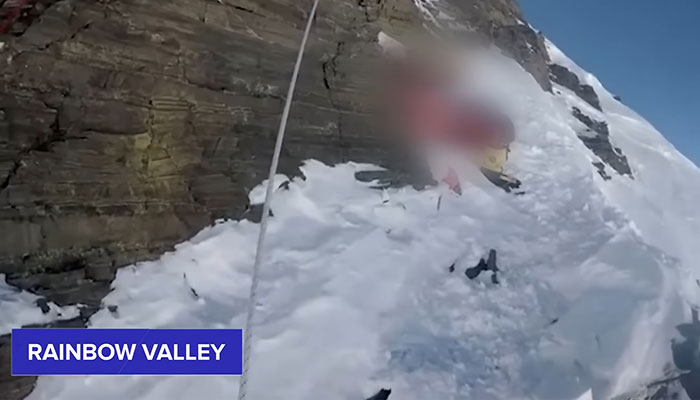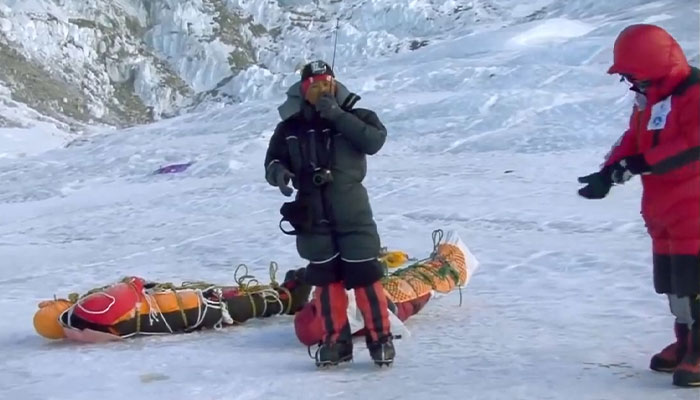Mount Everest’s melting ice and snow fuelled by climate change has started to expose hundreds of bodies of people who have succumbed to the dangerous summit. The problem has been particularly concentrated in the so-called “Death Zone,” where a team of professionals has been risking their own lives to bring corpses down. Five unnamed (as of yet) frozen bodies were retrieved — including one that was just skeletal remains — as part of Nepal’s mountain clean-up campaign on Everest and adjoining peaks Lhotse and Nuptse, CBS News reported on Thursday (June 27). As per the CBS News report, rescuers took hours to chip away the ice with axes, with the team sometimes using boiling water to release its frozen grip. Aditya Karki, a major in Nepal’s army who led the team of 12 military personnel and 18 climbers, told the American broadcaster: “Because of the effects of global warming, (the bodies and trash) are becoming more visible as the snow cover thins.”
Mount Everest’s melting ice, fuelled by climate change, has started to expose hundreds of bodies of people who have succumbed to the dangerous summit
Share icon Image credits: Grand Discovery Since expeditions to Mount Everest began in the 1920s, over 310 people have died attempting to summit the mountain, according to Big Think. The death toll has risen as more climbers have attempted the ascent, but the death rate has decreased due to improved safety measures and better equipment, as per MountEverest.info. The causes of death on Mount Everest vary, but the most common include acute mountain sickness, falls, avalanches, hypothermia, and exhaustion. The high-altitude “Death Zone” above 8,000 meters is particularly perilous due to the lack of oxygen, which severely impairs climbers’ abilities to make sound judgments and increases the likelihood of fatal errors, Big Think explains. Share icon Image credits: Our Amazing Home According to the latest figures from EverestMountain.co.uk, nine people have died on the mountain this year. These deaths encompassed Mongolian pair Usukhjargal Tsedendamba and Purevsuren Lkhagvajav, who were found high on Everest descending from the summit. They had reportedly climbed without Sherpa support or added oxygen. The word “Sherpa” is commonly used to describe someone who is a mountain guide or porter working in the Everest area, the BBC states. But Sherpa is actually the name of an ethnic group of people who live in the mountains of Nepal, central Asia. While descending from the summit, Daniel Paul Peterson and Pasang Tenji Sherpa were also caught in a sudden cornice fall and have not been found as of yet, EverestMountain.co.uk reported on June 1.
The problems have been particularly concentrated in the so-called “Death Zone”
Moreover, Kenyan mountaineer Cheruiyot Kirui went missing on May 22, and his body was found close to the summit soon after. Nawang Sherpa climbed with Cheruiyot but has reportedly not returned to base camp. A 37-year-old Nepali climber, Binod Babu Bastakoti, died at about 8,200 meters (26,902 feet) on May 22. Additionally, Banshi Lal, an Indian national, died at HAMS hospital in Kathmandu on May 27, where he was undergoing treatment. Banshi was rescued from Mount Everest and airlifted to Kathmandu on May 21 after displaying signs of acute mountain sickness. Finally, a 48-year-old Romanian, Gabriel Tabara, was found dead inside his tent at Camp Three on May 21. He was reportedly attempting to climb Lhotse without using supplementary oxygen. Share icon Image credits: Business Insider Many bodies remain in the Mahalangur Himal sub-range of the Himalayas, with some concealed by snow or lost in deep crevasses. Others, still dressed in their bright climbing gear, serve as somber landmarks along the route to the summit. Notable examples include “Green Boots,” the body of an unidentified climber on the main Northeast ridge route of Mount Everest, and “Sleeping Beauty,” identified as Francys Arsentiev, who died in 1998 during her descent. Army Major Aditya told AFP: “People believe that they are entering a divine space when they climb mountains, but if they see dead bodies on the way up, it can have a negative effect.”
A team of professionals has been risking their own lives to bring corpses down
One body, encased in ice up to its torso, took the climbers 11 hours to free, CBS News reported. Tshiring Jangbu Sherpa, who led the body retrieval expedition, admitted: “It is extremely difficult. “Getting the body out is one part, bringing it down is another challenge.” Tshiring reportedly said some of the bodies still appear almost as they had at the moment of death — dressed in full gear, along with their crampons and harnesses. Share icon Image credits: Everest Mystery The retrieval of corpses at high altitudes is a controversial topic for the climbing community, costing thousands of dollars, with up to eight rescuers needed for each body, CBS News reported. A body can weigh over 220 pounds (just under 100 kilograms), and at high altitudes, a person’s ability to carry heavy loads is severely affected. Nevertheless, Aditya explained: “We have to bring them back as much as possible. “If we keep leaving them behind, our mountains will turn into a graveyard.”
Five unnamed frozen bodies were retrieved — including one that was just skeletal remains
Share icon Tshiring said that bringing one body down from close to Lhotse’s 8,516-metre peak — the world’s fourth-highest mountain — has been among the hardest challenges so far, according to the news outlet. He recalled: “The body was frozen with hands and legs spread. “We had to carry it down to Camp Three as it was, and only then could it be moved to be put in a sled to be dragged.”
The mountain’s slopes are “littered with discarded empty oxygen canisters, abandoned tents, food containers, and even human feces.” That litter has contaminated the local watershed. https://t.co/Nro5ajRTn9 pic.twitter.com/V2pULLtIIs — Nathaniel St. Clair (@NatStClair) December 18, 2023 Camp Three is a 30-degree snow slope with rocky exposed ledges on which climbers’ tents are perched, 360 Expeditions explains. This camp serves only as a short resting point. “You can’t linger at this height and doing anything as simple as crawling into your tent and taking off your crampons can be overwhelmingly exhausting,” 360 Expeditions states. Rakesh Gurung, from Nepal’s tourism department, reportedly said two bodies had been preliminarily identified, and authorities were awaiting “detailed tests” for the final confirmation. The retrieved bodies are now in the capital, Kathmandu, with those not identified likely to be eventually cremated, CBS News reported.
Nepal’s mountain clean-up campaign on Everest and adjoining peaks, Lhotse and Nuptse, was launched
— Morbid Knowledge (@Morbidful) January 4, 2024 The clean-up campaign, with a budget of over $600,000, also reportedly employed 171 Nepali guides and porters to bring back about 12 tons of garbage. Fluorescent tents, discarded climbing equipment, empty gas canisters, and even human excreta litter the well-trodden route to the summit, as per the broadcaster. Tshiring said: “The mountains have given us mountaineers so many opportunities. “I feel that we have to give back to them, we have to remove the trash and bodies to clean the mountains.” Each climbing season, over 600 climbers, along with numerous support staff, contribute to the growing trash problem on the mountain. On average, each climber generates about eight kilograms (18 pounds) of waste, including discarded oxygen canisters, food containers, and even human waste, according to the National Geographic Society.
“Time to bring them home,” a reader commented
Share icon Share icon Share icon Share icon Share icon Share icon Share icon Anyone can write on Bored Panda. Start writing! Follow Bored Panda on Google News! Follow us on Flipboard.com/@boredpanda!














